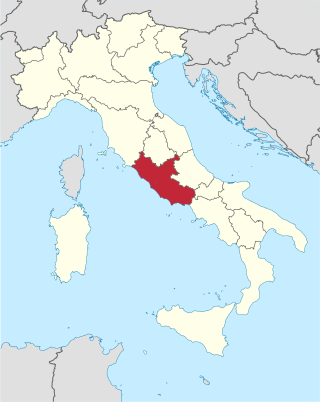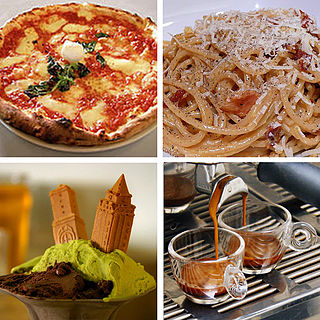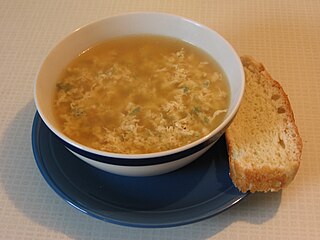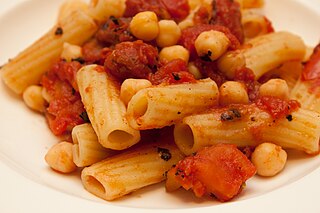
Trippa alla romana is a traditional dish of Roman cuisine.

Trippa alla romana is a traditional dish of Roman cuisine.
Once a popular dish among the poorest inhabitants of Rome, trippa alla romana has become a staple of Roman cuisine. It is part of quinto quarto (lit. 'fifth quarter', or the offal of butchered animals), [1] a type of cuisine born from poor, peasant kitchens. Each animal was divided into quarters (quarti); the first quarter (primo quarto) consisted of the best cuts and these went to the nobility. The second quarter was for the clergy. The third quarter (terzo quarto) was for the bourgeois (or merchant) class, and the fourth quarter was for soldiers. All that was leftover became quinto quarto and was distributed among the rest of the population, including the vaccinari (butchers). [2]
Trippa alla romana is an ancient recipe, traditionally prepared during Saturday lunch, so much so that nowadays in historic trattorias it is possible to see a sign that says "Sabato Trippa". [3]
The recipe of trippa alla romana has also spread thanks to Elena Fabrizi, an admirer of the popular dish of the Roman tradition. [4]
The dish is prepared with tripe, white onions, peeled tomatoes, carrots, white wine, pecorino romano cheese and pennyroyal leaves. [5]

Lazio or Latium is one of the 20 administrative regions of Italy. Situated in the central peninsular section of the country, it has 5,714,882 inhabitants and a GDP of more than €197 billion per year, making it the country's second most populated region and second largest regional economy after Lombardy. The capital of Lazio is Rome, which is also the capital and largest city of Italy, and completely encircles a foreign nation.

Gnocchi are a varied family of dumpling in Italian cuisine. They are made of small lumps of dough, such as those composed of a simple combination of wheat flour, potato, egg, and salt. Variations of the dish supplement the simple recipe with flavour additives, such as semolina flour, cheese, breadcrumbs, cornmeal or similar ingredients, and possibly including herbs, vegetables, and other ingredients. Base ingredients may be substituted with alternatives such as sweet potatoes for potatoes or rice flour for wheat flour. Such variations are often considered to be non-traditional.

Tripe is a type of edible lining from the stomachs of various farm animals. Most tripe is from cattle, pigs and sheep.

Pesto is a paste that traditionally consists of crushed garlic, European pine nuts, coarse salt, basil leaves, and hard cheese such as Parmesan or pecorino sardo, all blended with olive oil. It originated in Genoa, the capital city of Liguria, Italy.

Carbonara is a pasta dish made with eggs, hard cheese, fatty cured pork, and black pepper. It is typical of the Lazio region of Italy. The dish took its modern form and name in the middle of the 20th century.

In Mexican cuisine, Menudo, also known as pancita or mole de panza, is a traditional Mexican soup, made with cow's stomach (tripe) in broth with a red chili pepper base. Hominy, lime, onions, and oregano are used to season the broth. It differs from the Filipino dish of the same name, in that the latter does not use tripe, hominy, or a chili sauce.

Tripe soup or tripe stew is a soup or stew made with tripe. It is widely considered to be a hangover remedy.

Coda alla vaccinara is an oxtail stew in modern Roman cuisine including various vegetables, notably celery. The tail is considered offal, nicknamed in Rome the quinto quarto.

Italian cuisine is a Mediterranean cuisine consisting of the ingredients, recipes and cooking techniques developed in Italy since Roman times and later spread around the world together with waves of Italian diaspora. Some of these foods were imported from other cultures. Significant changes occurred with the colonization of the Americas and the introduction of potatoes, tomatoes, capsicums, maize and sugar beet—the latter introduced in quantity in the 18th century. It is one of the best-known and most appreciated gastronomies worldwide.

Sugo all'amatriciana or alla matriciana, also known as salsa all'amatriciana, is a traditional Italian pasta sauce based on guanciale, pecorino romano cheese, tomato, and, in some variations, onion. Originating from the town of Amatrice, the amatriciana is one of the best known pasta sauces in present-day Roman and Italian cuisine. The Italian government has named it a traditional agro-alimentary product of Lazio and amatriciana tradizionale is registered as a traditional speciality guaranteed in the EU and the UK.
In the cuisine of modern Rome quinto quarto is the offal of butchered animals. The name makes sense on more than one level: because offal amounts to about a fourth of the weight of the carcass; because the importance of offal in Roman cooking is at least as great as any of the outer quarters, fore and hind; and because in the past slaughterhouse workers were partly paid in kind with a share of the offal.

Carciofi alla giudìa is among the best-known dishes of Roman Jewish cuisine. The recipe is essentially a deep-fried artichoke, and originated in the Jewish community of Rome, giudìo being the term for Jew in the Romanesco language. It is a speciality of the Roman Ghetto, where it is served by Jewish restaurants in the springtime. In English the dish is usually referred to with the standard Italian spelling carciofi alla giudea; this spelling may be found in Italian sources as well, but the Roman dialect name is much more commonly used.

Neapolitan cuisine has ancient historical roots that date back to the Greco-Roman period, which was enriched over the centuries by the influence of the different cultures that controlled Naples and its kingdoms, such as that of Aragon and France.

Roman cuisine comes from the Italian city of Rome. It features fresh, seasonal and simply-prepared ingredients from the Roman Campagna. These include peas, globe artichokes and fava beans, shellfish, milk-fed lamb and goat, and cheeses such as pecorino romano and ricotta. Olive oil is used mostly to dress raw vegetables, while strutto and fat from prosciutto are preferred for frying. The most popular sweets in Rome are small individual pastries called pasticcini, gelato and handmade chocolates and candies. Special dishes are often reserved for different days of the week; for example, gnocchi is eaten on Thursdays, baccalà on Fridays, and trippa on Saturdays.

Venetian cuisine, from the city of Venice, Italy, or more widely from the region of Veneto, has a centuries-long history and differs significantly from other cuisines of northern Italy, and of neighbouring Austria and of Slavic countries, despite sharing some commonalities.

Carciofi alla romana is a typical dish of Roman cuisine of pan braised artichokes. During spring-time in Rome, the dish is prepared in each household and is served in all restaurants. It represents one of the most famous artichoke dishes of the Roman cuisine, another being carciofi alla giudia, a deep-fried artichoke dish that originated in the Jewish community of Rome.

Stracciatella, also known as stracciatella alla romana, is an Italian soup consisting of meat broth and small shreds of an egg-based mixture, prepared by drizzling the mixture into boiling broth and stirring. It is popular around Rome, in the Lazio region of central Italy. A similar soup, called zanzarelli, was described by Martino da Como in his 15th century manual The Art of Cooking. Other variants exist.

Pasta e ceci is a pasta dish common in southern and central Italy prepared with pasta and chickpeas as primary ingredients. It is part of the cucina povera, or peasant cuisine tradition in Italian cuisine.

Abbacchio is an Italian preparation of lamb typical of the Roman cuisine. It is consumed throughout central Italy as an Easter and Christmas dish. Abbacchio is a product protected by the European Union with the PGI mark.